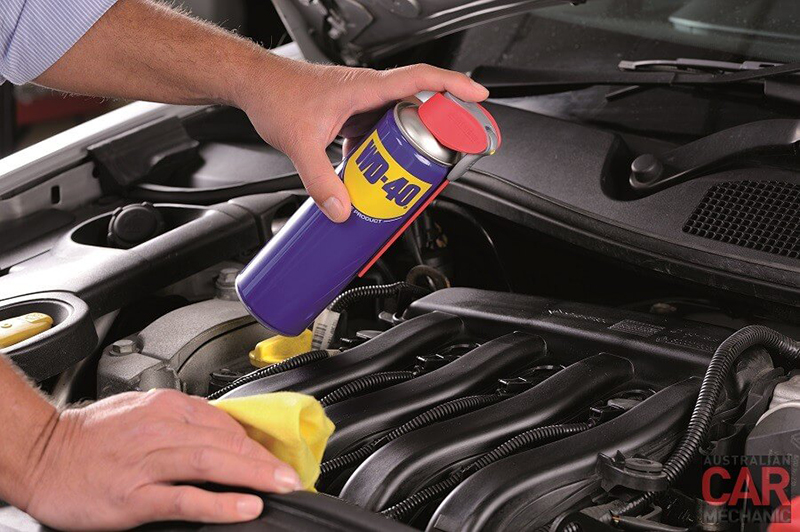If you’ve ever asked, “Can I use WD-40 on my engine?”, the short answer is yes—WD-40 is a powerful multi-use product that can help maintain your car engine in several ways. Whether you’re dealing with rust, moisture, or grime buildup under the hood, WD-40 can be a valuable tool in your car care kit. But like any product, it must be used properly to avoid damage or misuse.
In this blog, we’ll explore how to use WD-40 on a car, its applications, precautions, and how it supports vehicle longevity—especially for popular models like the Kia Sportage HEV and Kia EV5 FWD.
What Is WD-40 and How Does It Work?
WD-40 stands for “Water Displacement, 40th formula.” It’s a penetrating oil, lubricant, and moisture displacer all in one. Designed originally to prevent rust and corrosion on aerospace equipment, it’s now widely used in automotive maintenance.
When applied correctly, WD-40 helps to clean, protect, and lubricate engine components—aiding performance and preventing long-term wear.

Is WD-40 Good for Car Engines?
Yes, WD-40 is good for car engines when used appropriately. It’s ideal for:
-
Cleaning engine parts
-
Preventing rust
-
Removing moisture
-
Loosening stuck bolts and parts
However, it should never replace actual engine oil or be used as a long-term lubricant for moving engine components.
How to Use WD-40 on Your Car Engine
Here’s a step-by-step guide on how to use WD-40 on your car:
-
Cool Down the Engine: Never spray WD-40 on a hot engine. Let it cool down completely.
-
Disconnect the Battery: For safety, disconnect the battery to avoid any electrical issues.
-
Cover Sensitive Areas: Use plastic bags to cover components like the alternator, sensors, and air intake.
-
Spray Lightly: Apply a thin layer of WD-40 on metal engine surfaces and rusted bolts.
-
Wipe with a Clean Cloth: After a few minutes, wipe off the surface to remove grime and loosened dirt.
For owners of advanced models like the Kia Carnival Executive or the hybrid Kia Sportage Alpha, regular under-hood maintenance helps protect your vehicle investment.
 WD-40 Uses on Cars Beyond the Engine
WD-40 Uses on Cars Beyond the Engine
-
Door hinges – Silence squeaky doors
-
Spark plug wires – Prevents moisture and corrosion
-
Battery terminals – Helps avoid corrosion build-up
-
Locks and handles – Improves function and prevents freezing
Consider services like 3M Glass Coating Protection and Undercoating Car Protection for enhanced exterior maintenance as well.
Where Should You Not Use WD-40?
Avoid spraying WD-40 on:
-
Rubber parts (it can dry them out over time)
-
Timing belts or engine belts
-
Painted surfaces in large quantities
-
Brake components
For scheduled engine care, use this Online Service Appointment Form or reach out via the Online Inquiry Form.
FAQs About WD-40 and Car Engines
Is WD-40 safe for car engines?
Yes, when used correctly. Avoid electrical parts and always apply to a cool engine.
Where should I use WD-40 on my car?
Use on metallic engine surfaces, battery terminals, spark plug wires, and bolts.
How do you clean your engine with WD-40?
Spray lightly, wait a few minutes, and wipe with a clean cloth. Cover sensitive components before spraying.
Can you spray WD-40 on an engine belt?
No. WD-40 can cause belts to slip or degrade. Use designated belt dressings instead.
Is WD-40 flammable on the engine?
Yes, it is flammable. Always use it in a well-ventilated area on a cold engine.
What will happen if you use WD-40 as engine oil?
It will not lubricate properly and may damage internal components. Always use proper engine oil.
Can you use WD-40 on car windows?
Yes, but sparingly. It can help remove adhesives or water spots, but avoid using it regularly on glass.
Does WD-40 remove rust?
Yes. It’s effective in loosening and removing surface rust from metal parts.
How to clean out engine sludge?
Use a specialized engine flush product, not WD-40. WD-40 is good for surface cleaning, not deep internal sludge.
How to clean the engine bay with WD-40?
Spray on dirty areas, let it sit for 5-10 minutes, then scrub lightly and wipe off. Avoid spraying directly on sensors.
Is it safe to spray your engine with water?
Only if sensitive parts are properly covered. Use low pressure and never on a hot engine.
Extra FAQs
Can I use WD-40 on plastic car parts?
Use with caution. It can stain or degrade certain plastics over time.
Will WD-40 help start a wet engine?
Yes, it can help displace moisture from spark plug wires and ignition components.
Does WD-40 attract dirt?
If not wiped off properly, it may leave a residue that attracts dust and grime.
Final Thoughts
When asking, “Is WD-40 good for car engines?”, the key lies in proper application. Used responsibly, it can become your go-to solution for many common car issues. From maintaining your Kia Stonic EX Plus to enhancing your Sportage FWD performance, WD-40 offers convenience and protection.
To learn more about vehicle pricing, explore the Kia Price List and check out feature-packed models like the Kia Sportage L.













